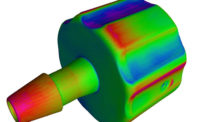Medical devices are unlike most mass-produced products, such as auto parts, razors, pens or spray pumps. Blood filters, catheters, diagnostic probes, syringes, ventilator tubes and other items need to meet strict criteria set by the Food and Drug Administration. Many products must undergo an intense premarket approval and validation process to ensure that they will not harm patients.
Medical device manufacturers have the same quality concerns as manufacturers in other industries, but they also face a much greater risk of lawsuits. "The potential liability associated with product failure is enormous," says Howard Speiden, project manager at systems integrator Sortimat Technology (Schaumburg, IL). "And a product recall generated by a failure in the field is extremely costly."
In addition to addressing cost, cycle time, throughput, waste reduction, time to market and other issues, medical device manufacturers must adhere to numerous health and safety requirements. As these demands become more stringent, test and inspection has become more critical. The accuracy, sensitivity, repeatability and reproducibility of test and inspection methods are critical. "The documentation required to validate tests tends to be more extensive in the medical device industry," says Speiden.
Leak testing is no exception to these demands. Because many medical devices have fluid management functions, they require complete leak testing.
Medical devices often form a barrier between fluids or gases that could create a danger for the patient if they were allowed to mix. Some devices are the route for delivery or extraction of fluids and form the pathway for the fluids.
"If a leak along the pathway exists, then the fluids could be delivered to the wrong part of the patient's body or bodily fluids could gather inside the body with dangerous consequences," warns Martin Bryant, marketing manager at Uson LP (Houston).
"Complete or partial blockage of medical devices could have fatal consequences, as could the failure of the device to deliver the correct dosage if required," adds Bryant. "For this reason, blockage, occlusion testing and flow measurement testing can be vital."
With medical devices, "it is important to perform a leak tests on 100% of the product without adding significant costs," says Gary Grebe, marketing director at Cincinnati Test Systems Inc. (Village of Cleves, OH). "Because leaks occur on a random basis, it is important to perform 100% testing and not sample testing.
"This requires a nondestructive test that evaluates the integrity of the product for significant leaks, performs the tests within the cycle time of the production process, and can be integrated into the production process."
Testing methods
Leak testing verifies the integrity of a manufactured product. Tests range from pressure testing and pressure decay to destructive burst testing and bubble break point testing. Testing equipment can be used to detect a variety of problems and flaws, such as gross leaks, fine leaks, blockage, cracks in seals, crimped lines, rolled seals, kinked hoses, and defective valves and pressure regulators.
Two basic methods are used to test products for leaks. In one method, the product is pressurized, isolated from the pressure source, and observed to detect escaping gas. Bubble, sniff, pressure decay, differential pressure, mass flow and mass spectrometry testing fall into this category. In the other method, the product is evacuated and then monitored to see if gas flows into it. Pressure rise and mass spectrometry are in this category.
Many types of fully programmable high-pressure leak testing devices are available, such as hydraulic pressure testers and gas-leak pressure testers.
Hydraulic pressure testers use distilled water as the pressure medium and deliver up to 2,000 psi. These devices are used for burst testing, fatigue testing and compliance measurement of medical tubing, plastic fittings, polymer balloons and other components.
Gas pressure leak testers operate with pure dry nitrogen. They are typically used for final product inspection, because the nitrogen gas does not contaminate the product.
In most industries, pressure decay or mass flow using air is the preferred method for leak testing. "The most common type of leak test across all industries is probably a simple water immersion test where the operator looks for the egress of air in the form of bubbles," says Bryant. The bubble test is the oldest leak testing method. A pressurized item is immersed in a water tank. If bubbles escape from the item, it leaks.
However, this is an unreliable and subjective test. Therefore, this test is less commonly used by medical device manufacturers.
"Testing with air and submerging the product under water and looking for bubbles is prevalent because of its low capital costs," notes Grebe. "But, bubble testing is losing favor because it relies on operator decision-making, contaminates the product, is [difficult to] automate and is not quantifiable."
According to Bryant, air-pressure decay or differential pressure testing is the most common type of test conducted in the medical device industry. In fact, he says it not uncommon for manufacturers to have 20 to 60 air pressure decay units in one facility.
With pressure decay leak testing, a medical device is pressurized, isolated from the pressure source, and monitored to see if the pressure decreases. Because air moves from a high-pressure area to a low-pressure area, a leak path can be detected in the chamber. Any reduction in pressure over time is displayed as a pressure change rate. Or, the pressure reduction can be converted by calculations to get the volumetric leakage rate.
In the differential pressure leak test, a reference volume is pressurized along with the test part. A transducer reads any pressure differential that develops over time between the leaking part and the nonleaking reference. Differential pressure testing is well-suited to applications requiring high test pressures. And, it typically provides higher sensitivity, more repeatability and faster test times than pressure-decay testing.
Traditional pressure decay leak testing measures the pressure at two points in time. However, these "simple two-point measurement systems are prone to error," warns Paul Tichauer, president of Sciemetric Instruments Inc. (Ottawa, ON). "The problem with this type of analysis is that it relies on only two data points. Reading electrical transducers always has some degree of uncertainty, due to electrical noise and other inaccuracies."
Tichauer claims signature analysis is a more accurate test method. Signature analysis tools capture leak test waveforms in real time and then apply algorithms to automatically analyze the entire leak curve instead of just measuring two points in time. "Using all the data points in the curve leads to increased accuracy, and better gage R&R (repeatability and reproducibility), for both pressure decays and mass flow leak testing," says Tichauer.
Numerous challenges
Engineers encounter numerous challenges when testing medical devices. For instance, a major factor in successful leak testing is correct clamping and sealing of the test piece. Medical devices frequently have small orifices and multiple transfer paths to test.
"This can make sealing and clamping more difficult than other applications," says Uson's Bryant. "This is especially so when considering automated test systems that may need to include material handling and delivery equipment."
In addition, many medical devices incorporate flexible components that are entirely made of flexible material. This can create difficulties with testing because of fluctuations in volume created by the distortion of the flexible material.
According to Bryant, ventilator parts are the most challenging medical devices to test, because precise multiple pressures may be required to test each part.
Jacques Hoffmann, president of InterTech Development Co. (Skokie, IL), says expandable devices, such as bags and catheters, are the most difficult products to test. "They cannot be accurately tested with low-cost pressure decay instruments," he says. "There is an increased awareness of requirements for gage R&R, which means that the low cost, marginally accurate test instruments currently in use are no longer meeting certain quality demands."
Leak testing becomes more difficult when several sequential tests are required. "For instance, catheters usually require a sequence of leak and flow tests on several lumens," says Cincinnati Test's Grebe. "Therefore, sealing and isolating the different lumens for a sequence for leak and flow tests without damaging the soft plastic components is the most difficult aspect of testing them."
Grebe believes the biggest challenge for any leak testing application is "developing low-cost, reliable sealing techniques that work within an automated production system. [Another] significant problem is dealing with expansion characteristics of plastic parts. Both issues affect the repeatability of test when integrated into higher speed production operations.
"Pressure decay and mass flow testing are based on the ideal gas law (PV = nRT), where volume and temperature changes affect the pressure in the part as much as the loss of air," adds Grebe. "When tests are performed rapidly, the pressure loss or flow readings are taken at unstable times for the part."
Testing trends
Nondestructive test methods and faster cycle times continue to be important to medical-device manufacturers. Other key leak testing requirements are reliability, the ability to challenge the test and the extent of validation.
"The degree of accuracy and sensitivity demanded has become higher," notes Bryant. "The desire to increase production rates and reduce costs has increased."
Growing demand for noninvasive surgery has also led to smaller and more precise components. Bryant says there's a growing trend toward higher and higher sensitivity. "After the threshold at which air-decay testing ceases to be accurate enough, then the industry is likely to be faced with higher costs in this area," says Bryant.
"Leak rates in general are getting tighter," adds Grebe. "Leak testing will continue to be integrated into the production process. But, the next trend will be automatic identification of leak location for process improvement and cost reduction." NDT




